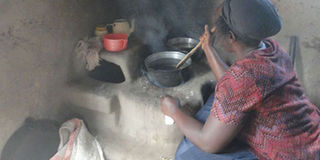Why you should open your windows wide when preparing meals this Christmas

Indoor air pollution from wood smoke poses the risk of lung diseases. PHOTO | EVANS HABIL | NATION
What you need to know:
- Christmas day has the highest levels of indoor pollution in households compared to any other day in the year, scientists warn. A new study published in the Proceedings of the National Academy of Sciences Journal indicates that indoor pollution peaks on Christmas day.
- Scientists have linked cooking activities accompanied with all the meal trimmings to a surge in indoor air pollution in homes, which shoots to the highest levels on the eagerly awaited day.
We are in the festive season and one thing is for sure — there will be a lot of cooking, feasting and everything that comes with Christmas and ushering in the New Year celebrations.
But even as you prepare your favourite festive meals, you will need to keep your windows wide open in order to safeguard your loved ones against health complications resulting from indoor air pollution.
Christmas day has the highest levels of indoor pollution in households compared to any other day in the year, scientists warn. A new study published in the Proceedings of the National Academy of Sciences Journal indicates that indoor pollution peaks on Christmas day.
Scientists have linked cooking activities accompanied with all the meal trimmings to a surge in indoor air pollution in homes, which shoots to the highest levels on the eagerly awaited day.
They have recommended opening windows during meal preparation in order to limit indoor air pollution during the festivities.
To arrive at the findings, researchers at the University of California in the United States analysed levels of pollution in the homes of about 4,000 families between 2021 and 2022.
They further examined “large emission events” whereby the level of microscopic particles of air pollution (particulate matter, PM2.5) spiked above normal ( 30 micrograms per cubic metre of air).
On Christmas day, 0.31 incidents were recorded daily in each household, which was the highest number of incidents.
Indoor pollution rates in households rose by almost double the rates recorded in summer and by half of what was witnessed during the cold season.
The scientists have expressed concerns over the increase of events which contribute to indoor air pollution that surpasses the recommended levels.
PM2.5 are tiny particles of air pollution which can reach the inner parts of the lungs when inhaled. The particles should not exceed five micrograms per cubic metre annual average, according to guidelines on the annual air quality by the World Health Organization (WHO).
Studies have attributed increased risk of respiratory diseases and heart complications to this type of air pollution.
The lead researcher, Dr David Lunderberg, explained that the air that is breathed in tends to be altered as people “spend more time cooking and more time at home.”
“Our data analysis on the quality of air in several households demonstrated a spike in indoor incidents, which emit particulate matter during the cold season and holidays that involve a lot of festive meals such as Christmas,” the study read.
The study reinforces previous research which highlights human activities as critical sources of particles indoors.
The study indicated higher levels of indoor air pollution during the times meals are typically prepared in households -— 8am, 12pm and 6pm.
Compared to midnight, the rate of emissions during dinnertime was about 10 times.
Air pollutants can be produced during cooking when food gets burned, braised or seared as well as residues that collect in the hob or oven when food get burned.
According to WHO, household air pollution was responsible for an estimated 3.2 million deaths per year in 2020, including over 237 000 deaths of children under the age of five.
At least 23,000 Kenyans die yearly from household air pollution from cooking with fossil fuels such as kerosene and firewood.



